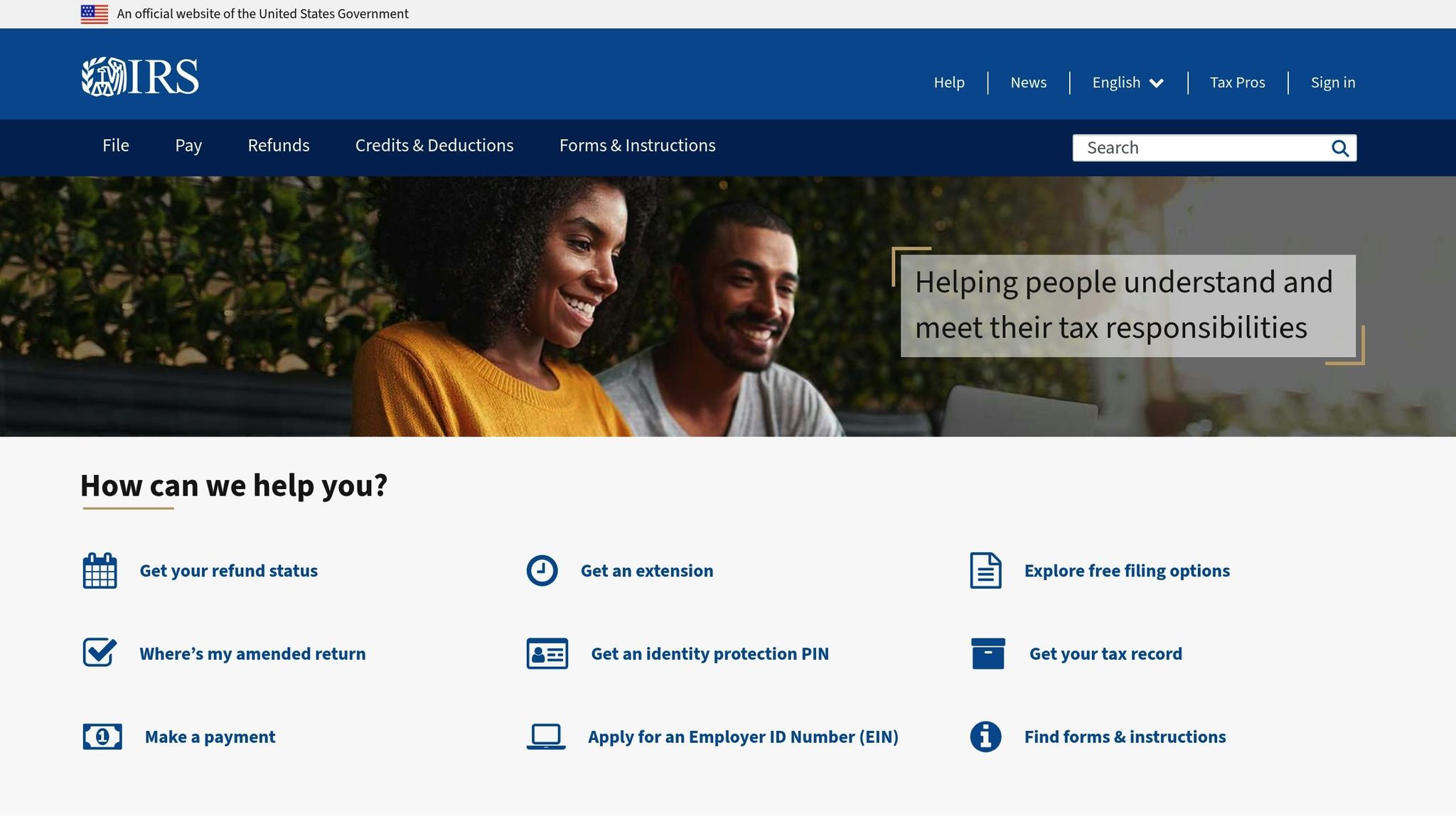Keeping payroll tax records isn’t optional - it’s a legal requirement. Here’s what you need to know:
- Retention Periods: The IRS requires payroll tax records to be kept for 4 years (e.g., Forms 941, W-2s, W-4s). Some records, like retirement plan contributions, must be kept for 6 years under ERISA.
- Key Documents: Retain tax forms, payment confirmations, employee details (e.g., Social Security numbers), and wage records.
- Penalties: Missing records can lead to fines up to $310 per form or higher for intentional violations.
- Digital Storage: Use secure, searchable systems with encryption, audit trails, and automated backups to meet compliance standards.
- Disposal Rules: Destroy records using compliant methods (e.g., shredders or digital erasure tools) and document the process to avoid penalties.
Why it matters: Poor record-keeping can result in IRS fines, legal disputes, and lost business opportunities. Regular reviews and digital tools can simplify compliance and save time.
How To Keep Payroll Records? - CountyOffice.org
Federal Laws for Payroll Record Keeping
The IRS and DOL have strict rules about payroll record retention, and failing to comply can lead to hefty penalties.
4-Year Record Storage Rule
According to IRS regulation 26 CFR § 31.6001-1, employers must keep employment tax records for four years. The clock starts ticking from either the tax return due date or the date the taxes were paid - whichever comes later. For example, if you file your Q2 2025 Form 941 on July 31, 2025, you’ll need to keep those records until July 31, 2029. In 2023, nearly 89% of IRS payroll audits requested records from the past three to four years.
Required Payroll Documents
Federal law requires employers to hold onto specific payroll documents. Here’s what you need to know:
| Document Type | Required Information | Retention Period |
|---|---|---|
| Tax Forms | Forms 941, 940, W-2s, W-4s | 4 years |
| Payment Records | EFTPS confirmations, deposit receipts | 4 years |
| Employee Data | Social Security number, address, occupation | 4 years |
| Wage Records | Pay rates, deductions, benefits | 3 years (FLSA) |
Some situations may require extending these retention periods.
Extended Storage Requirements
Under ERISA Section 107, retirement plan records, such as 401(k) contributions and employer matches, must be kept for six years - this takes precedence over the IRS’s four-year rule. Additionally, if there’s suspected fraud or significant underreporting of income (more than 25%), the statute of limitations no longer applies. For example, The Warnick Group successfully defended a $2.1 million S-Corp audit by maintaining six years of detailed compensation records.
Inadequate record retention is a major issue, contributing to about 62% of payroll compliance violations.
If you’re storing records digitally, the IRS has specific requirements. Records must be complete, legible, and searchable by employee details. Digital files should also maintain their original format and include access tracking and modification history, as outlined in Rev. Proc. 97-22.
Record Management Guidelines
Effective record management ensures digital storage, proper disposal, and regular reviews work together to meet compliance standards.
Digital Storage Methods
Digital storage is a practical solution for managing payroll records, offering both security and accessibility. Cloud-based systems with AES-256 encryption safeguard sensitive data while keeping it easily accessible for audits. In fact, a 2024 survey found that 89% of businesses with documented disposal processes avoided fines during audits.
When setting up digital storage, prioritize these key security features:
| Security Feature | Purpose | Compliance Benefit |
|---|---|---|
| Role-based Access | Restricts data visibility | Prevents unauthorized access |
| Audit Trails | Tracks document changes | Maintains chain of custody |
| Automated Backups | Protects against data loss | Ensures record availability |
| Encryption | Secures sensitive data | Meets IRS security standards |
After securely storing records, proper disposal is essential to maintain compliance and data integrity.
Record Disposal Process
Improper disposal of payroll records - whether digital or physical - can result in hefty penalties. For example, a Texas startup faced a $12,500 IRS fine in 2024 due to non-compliant disposal practices.
For digital records, use NIST 800-88 compliant erasure tools and maintain a detailed disposal log. Physical records should be destroyed using cross-cut shredders, with witness verification. Each disposal should include:
- Date and time of disposal
- Types of records destroyed
- Destruction method used
- Signatures of authorized personnel
- Copies of disposal certificates
Proper documentation ensures transparency and compliance during audits.
Regular Record Reviews
Quarterly reviews are critical to ensure records meet retention requirements. These reviews should check for completeness, confirm accessibility, and monitor retention deadlines. For instance, the 2025 California payroll tax amendment extended the retention period for health insurance records from 4 to 5 years. Companies with automated compliance tools adapted quickly, while those using manual processes faced difficulties.
During reviews, verify record dates, update access permissions, and ensure storage protocols align with current regulations. Automated systems, like Lucid Financials, can streamline this process by flagging records nearing retention deadlines and generating audit-ready reports. These tools can cut audit preparation time by up to 70%, making compliance management far more efficient.
sbb-itb-17e8ec9
Penalties for Missing Records
Failing to maintain proper payroll records can lead to hefty fines and serious legal trouble.
IRS Fines and Audit Challenges

The IRS enforces penalties under Internal Revenue Code §§6721 and 6722, with fines ranging from $60 to $310 per form in 2025, depending on the delay. These penalties can quickly add up for businesses with multiple violations.
| Violation Timing | Penalty per Form | Example Cost (10 Forms) |
|---|---|---|
| 1–30 days late | $60 | $600 |
| 31+ days late | $180 | $1,800 |
| Intentional disregard | $310 | $3,100 |
Missing records can also complicate IRS audits. For example, a Texas restaurant had to pay $127,000 in back taxes after the IRS reconstructed wages using credit card receipts due to missing payroll documentation. These audits often extend by 3–6 months, leading to higher tax reassessments.
In more severe cases, criminal penalties may apply. A Florida construction firm owner received an 18-month prison sentence in 2024 for willfully destroying payroll logs during an active audit. Beyond fines, poor record-keeping increases risks in wage disputes.
Risks in Employee Disputes
Lack of proper records undermines an employer’s ability to defend against wage disputes. According to the Department of Labor, 72% of wage and hour cases involving incomplete employer records result in judgments favoring employees.
For instance, in a 2024 California case, a warehouse worker was awarded $284,000 in overtime claims because the employer couldn’t provide clock-in records to refute the allegations.
The risks go beyond wage claims. A Michigan clinic faced $85,000 in HIPAA fines after improperly disposing of timesheets containing patient data.
Digital tools like Lucid Financials, which offer retention schedules and audit trails, provide added protection. Courts accepted such systems as valid evidence in 94% of employment cases in 2024. Regular system audits and encrypted backups further help businesses stay compliant and avoid costly penalties.
Conclusion
Keeping accurate payroll tax records is essential to protect your business from fines and legal troubles. The IRS requires businesses to retain these records for at least four years, but other regulations may demand longer retention periods.
Using digital tools for record management is a smart move. They help keep your documents secure, well-organized, and easy to access. This not only simplifies audits but also reduces compliance risks.
Failing to maintain proper records can lead to hefty IRS penalties, weaken your position in wage disputes, and disrupt your financial management - making it harder to grow your business effectively.
Tools like Lucid Financials can make compliance easier by automating checks and securely storing records with real-time updates. Regularly reviewing your records ensures they stay accurate and complete.
FAQs
What are the IRS requirements for storing payroll tax records digitally?
To comply with IRS standards, payroll tax records stored digitally must be accurate, accessible, and secure. The IRS requires that these records be retained for at least four years after the date the taxes were due or paid, whichever is later. Digital records should be organized and easily retrievable in case of an audit or review.
Ensure that your digital storage solution includes proper encryption and backup measures to protect sensitive employee and payroll data. It’s also a good practice to periodically review your records for accuracy and compliance with current IRS guidelines.
What is the best way to securely dispose of physical and digital payroll records while staying compliant?
To securely dispose of payroll records and avoid penalties, businesses should follow best practices aligned with federal and state regulations. For physical records, use shredding or certified document destruction services to ensure sensitive information is irretrievable. For digital records, implement secure deletion methods such as overwriting data or using specialized software designed to permanently erase files.
It’s also essential to maintain proper retention timelines before disposal. The IRS recommends keeping payroll tax records for at least four years after the tax becomes due or is paid, whichever is later. Regularly auditing your record management practices can help ensure compliance and minimize risks.
What happens if I don’t keep payroll tax records for the required time, and how can digital tools help ensure compliance?
Failing to retain payroll tax records for the legally required period can lead to serious consequences, including fines, penalties, and difficulties during audits. The IRS typically requires businesses to keep these records for at least four years after the tax becomes due or is paid, but state requirements may vary.
Digital tools can help you stay compliant by automating record-keeping, securely storing documents, and providing reminders about retention timelines. Platforms like Lucid Financials integrate with payroll systems to ensure your records are organized, accessible, and up-to-date, reducing the risk of errors and making audits much smoother.

